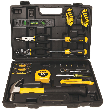Installing a Wall-Hung Sink
Written by Lee Wyatt (last updated August 7, 2020)
There are times when you simply get tired of an existing sink, and in those situations you need to do one of two things. Either you replace the sink yourself, or you hire someone to do it for you. If you are looking to do your own work, then you may want to consider installing a wall-hung sink. While not particularly difficult, it is a project that can take up to six hours to complete.
Before you begin this project, you should be aware that there is a small limitation to these directions. That limitation is that you will be installing a wall-hung sink from scratch, and not replacing an existing wall-hung sink. If you are replacing an existing wall hung sink, then you can simply skip to step six. Otherwise, you will need to start from the beginning. In addition, the directions here assume that you have already removed the existing sink, and any cabinets that may be in the location of your future wall-hung sink.
Materials:
- Wall-hung sink
- Silicone caulking
- 2 inch x 4 inch brace
- Mounting bracket
- Faucets and fittings
- Drywall tape
- Drywall compound
- Water-resistant drywall
- Anchor bolts
- 2 inch x 10 inch wood blocking
- Keyhole saw
- Rags
- Screwdriver
- Utility knife
- Caulking gun
- Ratchet wrench
- Socket set
- Power drill
- Drill bit set
- Tape measure
- Hammer
Procedure:
- Cut away the wall. Use a keyhole saw, and begin cutting away a 16 inch x 16 inch section of drywall in your bathroom. Be careful as you do this that you do not cut through any existing studs on a load bearing wall, or that you cut through any wiring or pipes that may be in place. Properly discard your old materials, or you can save the old drywall for later use (as long as it isn't too damaged).
- Install the blocking. Nail the 2 inch x 10 inch piece of wood blocking into place between the studs. As you are nailing it in place, have a friend or helper hold the blocking so that it is flush against the leading edge of the studs. Hammer the nails at an angle into the wood, so that it will go into the studs.
- Get the right drywall. Cut your water-resistant drywall to the same size as the hole in the wall. Place the drywall over the hole, and attach it to the blocking.
- Finish and paint the drywall. Finish and paint the drywall so that it matches the rest of your wall. Allow the paint to completely dry before proceeding with the rest of the project.
- Attach the mounting bracket. Attach the mounting bracket to the blocking and drywall. Have it set at the appropriate height for your sink, where it will be comfortable for you to reach and where you won't be leaning on it once you have installed your wall-hung sink.
- Attach the faucet and drain. Attach the faucet and drain to the sink. Be sure that you also apply silicone caulking around the edge of the drain before you set it in so that there is a nice watertight seal.
- Run the lines. Run your supply line, along with the stop valves, as well as the drain line and the P-trap. These items must be in place before you can set the sink into place.
- Set the sink. Set the sink onto the mounting bracket. Secure the sink by tightening the anchor bolts. Do not tighten them too far, or you could end up damaging the porcelain of the sink, or the mounting bracket itself.
- Attach the lines. Connect your lines to their appropriate locations on the faucets, and the drain. Ensure that all connections have been coated with some silicone caulking to ensure a watertight seal that will not allow any leaks.
- Tighten all seals. Check to ensure that all seals, connections, and lines are properly tightened one more time. Place an empty bucket under the sink.
- Check your work. Turn the water supply on, and test your work. If you notice any drips, leaks, or other problems, immediately turn off and drain the water into the bucket. If necessary, fix the leaks, and then test again. Otherwise, clean up your mess and enjoy your newly installed wall hung sink.
Author Bio
Lee Wyatt
Contributor of numerous Tips.Net articles, Lee Wyatt is quickly becoming a regular "Jack of all trades." He is currently an independent contractor specializing in writing and editing. Contact him today for all of your writing and editing needs! Click here to contact. Learn more about Lee...
Protecting Unfinished Hardwood Flooring
If you are looking for a truly unique and beautiful addition to your home decor, then you may have considered using ...
Discover More
Apple Mash
Apple mash is a wonderful dish that has long been a favorite in Emerald Isle. Learn a little more about this great dish ...
Discover More
Bacon and Apple Sandwiches
Whether it is for a snack, or even a full meal, sandwiches can certainly hit the spot. If you are tired of the same old ...
Discover More
More Home Improvement Tips
Installing a Shower
Installing a shower is a great way to not only increase the property value of your home, but give you more options for ...
Discover More
Keeping Your Pipes from Freezing
If you've ever experienced the aftermath of frozen water pipes, then you've probably already taken measures to ensure ...
Discover More
Foul Water Odor
Got a foul odor coming from your water tap? It could be caused by a number of different issues, as discussed in this tip.
Discover More

Comments